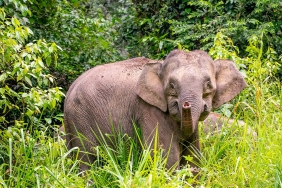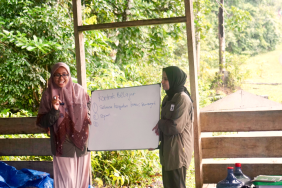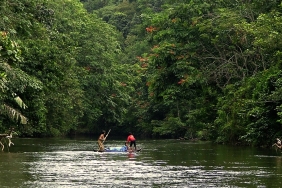HUMAN-ELEPHANT CONFLICT AT A GLANCE
By: Rafselia Novalina
Who hasn't heard of animal-human conflict? Chances are most of you have heard of it. Human-elephant conflicts, for example, are often featured in the headlines of national media and online news pages these days. However, do we all have the same understanding of what conflict is?
Conflict between elephants and humans has many dimensions. From the definition alone, for example, different people can have different perceptions of whether an event can be called a conflict or not. When an elephant is spotted in a field, several bystanders may perceive it differently, depending on many things such as their background or experience, their association with the location and the animal, and various other factors.
Some members of the public may even ask, "Are humans and elephants really in conflict?" This question arises from ignorance about the conflicts that occur between humans and elephants and other wildlife. People generally know that humans are sometimes disturbed by elephants. However, confirming whether or not an event is a conflict generally requires a lengthy process of discussion and common perception.
Apart from the definition of an incident, another dimension of animal-human conflict is the consequences. A conflict generally results in losses, both material and mental. The presence of elephants in plantation areas, for example, can result in the destruction of crop commodities. When elephants are present in settlements, the casualties can be in the form of damaged houses or other facilities, sometimes even injuries and loss of life. Although difficult to calculate or assess, the anxiety felt by humans due to elephant or wildlife disturbances is also very often felt and impossible to ignore.
Human-Elephant Conflict
Riau Province is one of the centers of elephant distribution in Sumatra. There are about nine pockets of elephant habitat, including the three main ones of Tesso Nilo, Balairaja-Giam Siak Kecil, and Serangge. However, over the past 25 years, Sumatra's largest province has also experienced a rapid rate of forest loss. As a result, as Sunarto wrote in Mongabay Indonesia, "About 70% of its habitat has been lost or degraded in just one generation (25 years) since 1985. A total of 23 elephant population pockets also experienced local extinction in that period, most of which were in Lampung and Riau."
What caused the loss and reduction of habitat and population of Sumatran elephants?
One of the causes is the narrowing of the elephant's home range, which has been converted into plantation forests, plantations, and settlements. It also triggers higher conflict intensity because elephants and humans use the same land at the same time.
From the elephant's point of view, they will see their actions such as visiting community plantations as not a mistake, because the location is part of their home or home range for generations. Whereas from a human perspective, they open plantations or settlements there to get a better life for their economy and livelihood.
Unfortunately, in clearing land, forest cleavers rarely pay attention and consider the condition and function of an area or land to be cleared. Conflicts can actually be prevented if people pay attention to these signs. In addition, before entering an area, especially opening it for plantations and settlements, people should also find out and try to better understand the existence and behavior of animals including elephants.
Such ignorance triggers conflicts between humans and elephants, such as what happened on February 26, 2016 at Artificial Lake, Pier 2, Okura Village RT 01 RW 04, Rumbai Pesisir Subdistrict, Pekanbaru City. As reported, a wild elephant entered a residential area in Danau Buatan area which is 30 minutes away from Pekanbaru. The presence of the elephant made the residents scared and anxious. People were worried that the elephant would attack them, their houses and plantations. To anticipate this, a joint mitigation team consisting of WWF Indonesia Central Sumatra Program, BBKSDA Riau, police and the community monitored the movement of the elephant and evacuated 4 families who were around the area where the wild elephant moved.
Based on interviews with several residents around the scene, they questioned, "How could an elephant enter the city? There is no forest here anymore. Based on science, the elephant did not enter the city, but one of its patterns or behavior in tracing its traditional path, even though the path has changed into plantation forests, plantations and settlements. Another cause is the need for food that must be met by elephants and following adult male elephants who are looking for their territory.
The case of elephants entering the city is one of the typical conflicts that often occur in Riau Province and other areas that have elephant pockets such as Aceh and Lampung.
A Brief Understanding of Conflict between Humans and Elephants
Understanding the conflict between humans and elephants can be done to the whole community in general, as well as to specific communities that often come into contact with elephants. The understanding of the conflict can be done together by strengthening the awarenes team to educate people who intersect with elephant habitat about the behavior of Sumatran elephants (Elephas maximus sumatranus) and other wildlife. So that people can better understand and know how to prevent conflict early.
It would be a beautiful impact in the future if the strengthening of awarenes is successful in an area where humans and elephants coexist by utilizing their respective spaces. This can be done together consciously if we are willing to try to restore the natural habitat of elephants and utilize the habitat wisely and sustainably. If this happens, humans, elephants or other wildlife will live harmoniously in nature. Conflicts between humans and elephants or other wildlife are reduced, wildlife populations do not decline, forests come back to life and humans can get sustainable benefits from forests.





